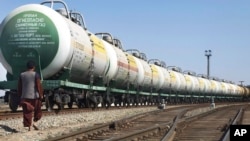Central Asia today is one of the least integrated regions in the world, with only six percent of total trade occurring within the region. This fact flies in the face of the region’s history, since by virtue of its geography, Central Asia, along with southern Caucasus to the west, has for hundreds of years served as a hub of interlinking trade routes through which goods, people and ideas passed from one continent to another.
The United States believes that because stronger regional ties tend to accelerate economic growth, Central Asia’s future lies in creating regional markets, facilitating trade and transit, streamlining customs and border crossings, and connecting people and businesses.
“To expand the region’s potential as a trade corridor, countries in the region must work together to limit border delays and reduce transport costs,” said Richard Hoagland, Principal Deputy Assistant Secretary for South and Central Asian Affairs.
And increasingly, we are seeing changes that make trade and transport easier, from new and expanded port facilities in Kazakhstan and Turkmenistan that are mirrored across the Caspian Sea in Azerbaijan, to improved railroads from Uzbekistan to Afghanistan, with hundreds of kilometers of trans-regional rail line extensions in the planning stages.
Such projects, and many more, have already led to improved regional trade and transportation. It’s a good start. At this point, we encourage all regional partners to continue to diversify and expand the trade and transport routes, and to build economic growth throughout the region, said Principal Deputy Assistant Secretary Hoagland.
And we believe that our New Silk Road initiative will help.
“Through development of a regional energy network, better trade and transport links, streamlined customs and border procedures, and greater people-to-people and business-to-business ties, the New Silk Road initiative supports a more stable, secure and prosperous future for Afghanistan and its neighbors in Central and South Asia,” said Principal Deputy Assistant Secretary Hoagland.
“Looking at the countries of Central Asia, the United States will continue to support efforts for greater regional economic connectivity. A focus on Central Asia’s links to the Caspian, the Caucasus, Turkey, and Europe and beyond is important . . . . for the future of the countries in the region.”

















